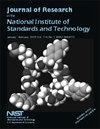拟合距离数据的平面参数方差。
IF 1.5
4区 工程技术
Journal of Research of the National Institute of Standards and Technology
Pub Date : 2010-12-01
Print Date: 2010-11-01
DOI:10.6028/jres.115.032
引用次数: 2
摘要
导出了三维成像系统(如LADAR)获取的点云平面参数的非线性最小二乘拟合方差公式。讨论了用于最小化的两种不同的误差目标函数:正交函数和定向函数。对相应公式的比较表明,当应用于同一数据集时,这两个函数可能会产生不同的结果。本文章由计算机程序翻译,如有差异,请以英文原文为准。

Variances of Plane Parameters Fitted to Range Data.
Formulas for variances of plane parameters fitted with Nonlinear Least Squares to point clouds acquired by 3D imaging systems (e.g., LADAR) are derived. Two different error objective functions used in minimization are discussed: the orthogonal and the directional functions. Comparisons of corresponding formulas suggest the two functions can yield different results when applied to the same dataset.
求助全文
通过发布文献求助,成功后即可免费获取论文全文。
去求助
来源期刊

Journal of Research of the National Institute of Standards and Technology
Engineering-General Engineering
自引率
33.30%
发文量
10
期刊介绍:
The Journal of Research of the National Institute of Standards and Technology is the flagship publication of the National Institute of Standards and Technology. It has been published under various titles and forms since 1904, with its roots as Scientific Papers issued as the Bulletin of the Bureau of Standards.
In 1928, the Scientific Papers were combined with Technologic Papers, which reported results of investigations of material and methods of testing. This new publication was titled the Bureau of Standards Journal of Research.
The Journal of Research of NIST reports NIST research and development in metrology and related fields of physical science, engineering, applied mathematics, statistics, biotechnology, information technology.
 求助内容:
求助内容: 应助结果提醒方式:
应助结果提醒方式:


